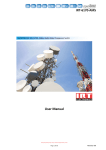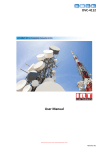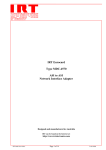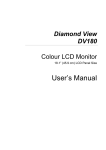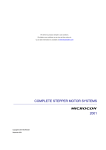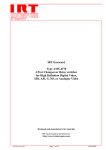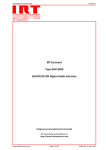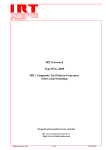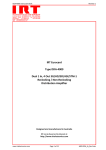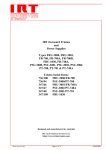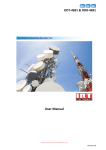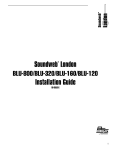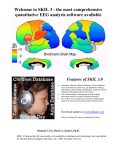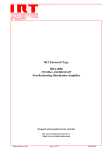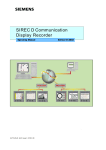Download FRU-1040 User Manual (Revision 02)
Transcript
FRU-1040 1RU Frame with built in DC PSU User Manual IRT Electronics Pty Ltd | www.irtelectronics.com Revision 02 FRU-1040 1RU FRAME WITH BUILT IN DC PSU Revision History: Revision 00 01 02 Date 02/02/2009 20/01/2011 25/05/2012 By AL AL AL Change Description Original Issue. Correction to front panel drawing. Reformatted layout. Applicable to: S/N: ≥ 0807001 S/N: ≥ 0807001 S/N: ≥ 0807001 IRT Electronics Pty Ltd | www.irtelectronics.com Page 2 of 20 Revision 02 FRU-1040 USER MANUAL Table of Contents: Section Page Revision History 2 Operational Safety 4 FRU-1040 IRT 1RU DC Chassis Frame for Eurocards General Description Technical Specifications Configuration Installation of Modules Eurocard Module EMC Front, Rear & Top panel diagrams 5 5 6 7 8 8 9 10 CDM-1000 SNMP Agent Frame Controller General Description Technical Specifications Installation CDM-1000 Front panel connector diagram Setup 11 11 12 13 13 14 SMU-4000 SNMP Plug-in Management Controller General Description Installation 16 16 17 SNMP – What Is It? 18 Maintenance & Storage 20 Warranty & Service Equipment return 20 20 This instruction book applies to units later than S/N: 0807001. IRT Electronics Pty Ltd | www.irtelectronics.com Page 3 of 20 Revision 02 FRU-1040 OPERATIONAL SAFETY WARNING Operation of electronic equipment involves the use of voltages and currents that may be dangerous to human life. Note that under certain conditions dangerous potentials may exist in some circuits when power controls are in the OFF position. Maintenance personnel should observe all safety regulations. Do not make any adjustments inside equipment with power ON unless proper precautions are observed. All internal adjustments should only be made by suitably qualified personnel. All operational adjustments are available externally without the need for removing covers or use of extender cards. IRT Electronics Pty Ltd | www.irtelectronics.com Page 4 of 20 Revision 02 FRU-1040 GENERAL DESCRIPTION The FRU-1040 chassis with integral DC power supply provides a means of mounting either one or two IRT Eurocard modules in a single rack unit, where only a low voltage DC supply is available. This provides a convenient format for situations where only a small number of modules are required and space is at a premium. The FRU-1040 differs from the AC 1RU chassis only in the provision of a DC supply input in the range of 20 to 70 Volts instead of the AC mains input. The DC input may be either positive or negative earth. The FRU-1040 is supplied with blank plates covering the right hand module position to enhance the safety and appearance of the unit when only one card is fitted. A single power supply only is provided, so if power supply redundancy is required users should select one of IRT's 3RU frames. Standard features: • • • • Built in power supply. Suit IRT’s current 4000 series Eurocards. Take up to two Eurocard modules. Optional plug in Simple Network Management Protocol (SNMP) card. IRT Electronics Pty Ltd | www.irtelectronics.com Page 5 of 20 Revision 02 FRU-1040 TECHNICAL SPECIFICATIONS Power requirements: Voltage Power Fusing 20 to 70 Vdc positive or negative ground (FRU-1040 set up for positive ground as standard) 1 A maximum 500 mA anti-surge ±16 Vdc; 10 VA maximum Output: Connectors: DC power input Klippon MK1/3 termination block. Other: Temperature range 0 - 50° C ambient. 1 RU (482 mm x 44.5 mm) standard 19” rack frame; Suitable for mounting in standard 19" racks. 482 x 44.5 x 238 mm (frame empty); Clearance width 442 mm. Mechanical Dimensions Finish Front Panel Body & rear panel Grey background, black lettering and red IRT label. Aluminium with silk screened black lettering. Optional Accessories: CDM-1000 Simple Network Management Protocol (SNMP) controller card for use with 4000 series Eurocards fitted with SNMP capability. Internal power cable for older style rear assembly compatibility. Due to our policy of continuing development, these specifications are subject to change without notice. IRT Electronics Pty Ltd | www.irtelectronics.com Page 6 of 20 Revision 02 FRU-1040 CONFIGURATION WARNING: DC supply systems are normally capable of supplying very large currents. Whilst the voltage may be low the current capability is sufficient to provide sufficient power to melt steel parts or weld screwdrivers or other tools to bus bars or chassis. Serious damage and personal injury can result if extreme care is not taken. Before making any DC connection, check whether a positive or negative ground system is required. The following internal links must be set to the correct positions before DC is connected or components may be damaged. Once the links have been set they should be checked carefully before a DC input is connected. For negative ground systems (positive supply) install the following links: LK 1, 4, 6 & 7. Do not install links LK 2, 3, 5 & 8. For positive ground systems (negative supply) install the following links: (e.g. Telecoms –48 Vdc) LK 2, 3, 5 & 8. Do not install links LK 1, 4, 6 & 7. Link LK 9 provides a connection between circuit ground and chassis ground. This is provided to allow flexibility in earthing arrangements for the minimisation of noise. If in doubt this link should be installed. If it is not installed a separate earth must be provided to the chassis. This may be provided through the rack mounting of the chassis where an earth is connected to the rack provided a low Ohmic contact is made between chassis and rack. NOTE: The FRU-1040 comes factory set up for positive ground as standard for use with –48Vdc systems. IRT Electronics Pty Ltd | www.irtelectronics.com Page 7 of 20 Revision 02 FRU-1040 Installation of Modules CDM-1000 SNMP Agent Module See CDM-1000 installation section of this manual. Eurocard Module In order for an IRT Eurocard to be mounted within the FRU-1034 frame, the rear assembly must be fitted with power pins (10-pin) to pick up power from the frame power bus. All IRT 4000 series cards come fitted with these pins and are fully compatible with the FRU-1034 frame as are current 700 and 3000 series Eurocard modules that have the correct type of power connector on the rear assembly. Older versions of 700 and 3000 series Eurocard modules that do not have the power pins on the rear assembly need an additional internal power cable added to connect up to the 3-pin power connector common to all IRT Eurocard modules. SNMP Pins (6 pin) for FRU-1034 and 4000 series frames. Power Pins (3-pin) for older style 1RU frame. Power Pins (10-pin) for FRU-1034 and 4000 series frames. Typical 4000 series Eurocard rear assembly showing locations of power and SNMP pins. IRT Electronics Pty Ltd | www.irtelectronics.com Page 8 of 20 Revision 02 FRU-1040 Ensure that the rear assembly has the correct orientation and carefully align the power pins and SNMP pins over power and SNMP bus connectors. With equal pressure, press until the rear assembly PCB touches the frame. Install the two retaining screws (Metric M2.5 x 6 mm). Rear of FRU-1040 SNMP Bus Pins Eurocard Rear Assembly Power Pins Rear assemblies may be removed for maintenance. Make sure that extraction force is applied equally and steadily at the top and bottom of the rear assembly simultaneously. If extraction force is not equally applied, there is a good chance that the module connector pins will be bent, making it very difficult to re-install the rear assembly. Slide the Eurocard module into the front of the frame in the guides corresponding to the position of the installed mating rear assembly until it makes mating contact with the rear assembly 64 pin connector, then tighten the two front retaining screws. Warning Optical Connections The optical connectors on modules may be attached to the main module PCB, NOT the rear connector assembly. When installing the optical fibre sufficient slack should be allowed for the module to be withdrawn with the optical fibre attached until the connector is clear of the frame and can be disconnected. If this is not done, the module will not be able to be removed without first disconnecting the optical fibre at the rear. Attempting to remove the module without first disconnecting the fibre may result in damage to the fibre and / or the module. EMC Due to EMC (electromagnetic compliance) standards, IRT recommends that all unused card positions be closed off using IRT front blanking panels, on the front, and rear blanking panels, on the rear, of the frame. IRT Electronics Pty Ltd | www.irtelectronics.com Page 9 of 20 Revision 02 FRU-1040 Front, Rear & Top panel diagrams: The following front, rear and top panel diagrams are intended to show relative positions of controls and modules and are not to scale. Front view: FRU-1040 FRAME DC Rear view: Rating: ±20 – 70Vdc 1.0A Positive or Negative Ground is linked to supply internally This unit is set to: + Ground - Ground FRU-1040 FRAME 1 2 3 Only remove this cover to install Network Management Module + - Top View: IRT Electronics Pty Ltd | www.irtelectronics.com Page 10 of 20 Revision 02 CDM-1000 FRU-1040 SNMP AGENT FRAME CONTROLLER GENERAL DESCRIPTION The CDM-1000 is a Simple Network Management Protocol (SNMP) Agent for use in IRT’s FRU-1034 1RU frame. It occupies its own designated slot in the rear of the frame, next to the power input socket, so it does not affect the number of modules that can be used within the frame. The CDM-1000 can communicate with all modules in an FRU-1034 frame that are fitted with an SMU-4000 SNMP Interface sub-board, or have inbuilt SNMP facilities. The information obtained is forwarded via an Ethernet connection to any SNMP Network Management System (NMS) whose address is configured in the CDM-1000. The CDM-1000 holds parameters such as Frame Name, Address and Location. This information may be set via an RS232 Configuration port. The NMS third party software (not supplied by IRT) polls the CDM-1000 to remotely monitor and control the frame and its SNMP capable modules. In the event of a major alarm from any of the modules an alarm condition, known as a Trap, is automatically sent without any prompting from the NMS. A relay output indicates loss of power to the frame that it is plugged into. Ethernet connection is via an RJ45 connector and the RS232 is via a D9 female connector on the rear of the frame. Modules that are being monitored and controlled share a common data bus on the frame. SNMP monitoring and control finds particular use in remote or unmanned locations such as transmitter sites, or where control via a computer is desired. As the CDM-1000 can be assigned its own IP Address, multiple sites can be monitored and controlled via the one NMS. Alternatively, multiple NMS’s in different locations can be used to monitor and control the same site. Standard Features: • • • SNMP remote monitoring and control via Ethernet connection. Automatic “Trap” transmission on major alarms. Own designated slot in the FRU-1034 1RU frame. IRT Electronics Pty Ltd | www.irtelectronics.com Page 11 of 20 Revision 02 CDM-1000 FRU-1040 TECHNICAL SPECIFICATIONS Ethernet: Rate Connector 100 baseT\ 10 baseT. RJ45. RS232: Rate Connector 9600 baud. Female D9. SNMP: Version Configurable settings 1. sysContact; sysName; sysLocation; Agent IP address; NMS IP address (max 5); Gateway IP address; Subnet mask; Community; Agent port number; Trap port number. Power Requirements: Voltage Power consumption 28 Vac CT (14-0-14) or ± 16 Vdc. < 5 VA. Other: Temperature range 0 - 50° C ambient. Mechanical Suitable for mounting in IRT 1RU 19” rack chassis with SNMP capability. Due to our policy of continuing development, these specifications are subject to change without notice. IRT Electronics Pty Ltd | www.irtelectronics.com Page 12 of 20 Revision 02 CDM-1000 FRU-1040 INSTALLATION If the FRU-1034 frame is to be fitted with SNMP capability, then the CDM-1000 SNMP Agent module needs to be installed. Viewed from the rear, the CDM-1000 occupies its own designated spot to the left of the FRU-1034 frame. Remove the existing blanking panel, next to the power inlet connector, from the frame and slide the CDM-1000 into position being sure that the 10-pin connectors fully mate with the connectors on the frame. Secure with fitted mounting screws. Signal connections to this card are via the exposed panel of the CDM-1000 rear of the frame. The 9 pin female D9 connector is an RS-232 interface for connection to a computer for initial setup parameters of the frame for SNMP use. The RJ45 connector is for Ethernet connection. Alarm Output: In the event of a power failure to the frame a normally closed (N/C) to ground relay contact acts as an alarm via the 3-pin phoenix connector located next to the Ethernet connector. Whilst there is power to the board the alarm connector is open circuit. 1 Ground 2 Power Alarm 3 Ground Front panel connector diagram The following front panel drawing is not to scale and is intended to show relative positions of connectors, indicators and controls only. 1 SKR3 SKR1 2 3 SKR2 SKR5 SKR4 Network Management IRT Electronics Pty Ltd | www.irtelectronics.com Page 13 of 20 Revision 02 CDM-1000 FRU-1040 SETUP The communication between the CDM-1000 and the NMS’s use Ethernet at either 10 or 100Mb/s. The SNMP protocol used is Version 1. Read and Write functions use the same Community string. To obtain a response from a CDM-1000 the Internet Protocol (IP) Destination address must be the preconfigured Local IP Address, the IP Source Address must be one of the pre-configured NMS addresses, the UDP Port number must match the preconfigured Agent Port, and the Community string must match the pre-configured Community string. The Community string is also used to address individual modules. The frame slots are numbered from 1 to 2, left to right as viewed from the front of the frame. To address a module the first character of the Community string must be the module Slot number in ASCII. The second character must be “@”. The remaining characters must match the pre-configured Community string. For example suppose the Community was set as “public” then the module in Slot 1 would respond to “1@public” The CDM-1000 can also be addressed as being in slot ‘0’ (i.e. “0@public” or “public”). To configure the CDM-1000 connect an ASCII serial RS-232 terminal (such as Tera Term PRO) to the Configuration port. The data rate should be 9600 baud and the byte should 8 bits data, no parity 1 stop. Upon sending ‘Enter’ you would typically see the following: 1.Local MAC address 2.Local IP address 3.NMS 1 IP Address 4.NMS 2 IP Address 5.NMS 3 IP Address 6.NMS 4 IP Address 7.NMS 5 IP Address 8.Gateway IP Address 9. Subnet Mask A.Community B.Agent Port C.Trap Port D.sysContact E.sysLocation F.sysName 12:34:56:78:9A:DF 192.168.0.100 192.168.0.11 00:A0:CC:54:12:84 255.255.255.255 192.168.0.10 00:A0:CC:54:12:8E 192.168.0.24 00:A0:CC:54:12:86 192.168.0.9 00:09:5B:04:16:48 192.168.0.1 00:09:5B:12:33:15 0.0.0.0 public 161 162 John Doe Hotham Pde north side To change a parameter, type in the line number that you wish to change. As soon as the line number has been typed you are able to enter the new parameter data. Pressing the ‘Enter’ key will give you a message asking if you wish to replace the existing data with the new data. Press ‘Enter’ again to accept the change. Anything else typed will default back to the existing parameter. Local MAC address This is a unique address of this particular CDM-1000 and should only be changed with great care. Local IP address This is the static IP address assigned to the Frame by you or your ISP. NMS 1 IP Address This is the IP address of one of the NMS’s to which the CDM-1000 will respond. Up to 5 addresses can be used. If any one of the addresses is not required then the address 255.255.255.255 should be entered. Once communication has been established with a particular address then the MAC address used to communicate with that IP address will be displayed after the IP address. If the IP address is not within the local subnet as defined by the Gateway address and the Subnet Mask then instead of the MAC address the label “via Gateway” will appear. IRT Electronics Pty Ltd | www.irtelectronics.com Page 14 of 20 Revision 02 CDM-1000 FRU-1040 Gateway IP Address When using subnets a Gateway is the IP address of the computer appointed to pass on all messages that are addressed to computers that are not part of your subnet. The Gateway IP address must be in your subnet. Subnet Mask A subnet mask is used to determine if an IP address is within your subnet or not. If the IP address is within your subnet then you send messages directly to that IP address. If it is not then you send messages to the Gateway for it to pass on. Say the mask was 255.255.0.0 – and the destination IP address was 192.168.0.54 and the Gateway address was 192.168.0.1. Using binary logic you AND the IP address and the mask which results in 192.168.0.0 . Now AND the mask and the Gateway address and you get 192.168.0.0 . These two addresses match so the destination is in your local subnet. If you do not want to use Gateways set the Mask to 0.0.0.0 Community This is the Community string, which must be exactly matched for a response to be obtained. It is case sensitive and you may use non-printable characters. The maximum length is 63. Agent Port This is the Agents UDP Port number. SNMP Protocol suggests that this should be 161. Trap Port When a Trap (an unsolicited message from a module to a NMS) is sent the Trap Port number is used as the destination port. SNMP Protocol suggests that this should be 162. Note that when a module generates a trap, it is sent to all of the configured NMS addresses using this Port number. sysContact This string is sent when a ‘Get sysContact’ is sent to the CDM-1000. Maximum length is 63 and only printable characters should be used. sysLocation This string is sent when a ‘Get sysLocation’ is sent to the CDM-1000. Maximum length is 63 and only printable characters should be used. sysName This string is sent when a ‘Get sysName’ is sent to the CDM-1000. Maximum length is 63 and only printable characters should be used. IRT-MIB.my is an SNMP MIB, which contains the Object Identifier (OID) definitions of all IRT controllable modules. It also contains a small number of OIDs used by modules that do not have their own MIB. IRT4000FRU-MIB.my is an SNMP MIB for all IRT SNMP frames fitted with a CDM SNMP agent controller. A ‘Walk’ command to a CDM-1000 will show (in part) a list by slot number of the type of module installed. If enabled, Trap alarms can be individually enabled or disabled for each slot position. IRT Electronics Pty Ltd | www.irtelectronics.com Page 15 of 20 Revision 02 SMU-4000 FRU-1040 SNMP PLUG-IN MANAGEMENT CONTROLLER GENERAL DESCRIPTION The SMU-4000 is a Simple Network Management Protocol (SNMP) plug-in interface option for IRT 4000 series modules when used in IRT’s SNMP capable frames. The SMU-4000 is programmed with a Management Information Base (MIB) suitable for the type of module that it is to be plugged into. IRT 4000 series cards that are SNMP upgradeable need the SMU-4000 plug-in module programmed with their own relevant MIB to be recognisable by the SNMP system. The SMU-4000 acts as an interface between the module that it is plugged into and the CDM-xxxx SNMP Agent within the SNMP capable frame. Module conditions such as alarm states or signal conditions are communicated to the SNMP Network Management System (NMS) via the CDM-xxxx SNMP Agent. Likewise control commands are communicated from the NMS, to the SNMP Agent, to the relevant module via the SMU-4000 plug-in module. Standard Features: • • Plug-in SNMP option for IRT 4000 series cards Programmable Management Information Base (MIB) to suit intended module IRT Electronics Pty Ltd | www.irtelectronics.com Page 16 of 20 Revision 02 SMU-4000 FRU-1040 INSTALLATION The SMU-4000 plug-in SNMP management controller module can only be fitted to IRT’s 4000 series modules that are capable of being SNMP upgradeable. To determine whether a module is SNMP upgradeable, a square section on the main PCB is silk screened and fitted with three multipin sockets – as shown below: 1J1 1J3 1J2 This is where the SMU-4000 plug-in SNMP management controller module is fitted. The three sets of multipins on the underside of the SMU-4000 line up with the three sets of multipin sockets on the main PCB module. Align all pins and then gently press the SMU-4000 all the way down into place. If the SMU-4000 is not already programmed with the correct firmware to match the module that it is being plugged into, it then needs to be programmed via the pins on the topside of the SMU-4000. Note that installation will generally be done by IRT Electronics at the time of ordering. Note also that an SMU-4000 will only be functionally operational when the main module that it is plugged into is fitted into an IRT SNMP capable frame fitted with a CDM-xxxx SNMP agent and being interrogated by a suitable Network Management System. IRT Electronics Pty Ltd | www.irtelectronics.com Page 17 of 20 Revision 02 FRU-1040 SNMP What Is It? SNMP stands for Simple Network Management Protocol. It is an application layer protocol for managing IP (Internet Protocol) based systems. SNMP enables system administrators to manage system performance, and to find and solve system problems. SNMP runs over UDP (User Datagram Protocol), which in turn runs over IP. Three types of SNMP exist: SNMP version 1 (SNMPv1), SNMP version 2 (SNMPv2) and SNMP version 3 (SNMPv3). It is not the intention here to discuss the differences between various versions, only to bring attention to the fact that IRT Electronics modules, fitted with SNMP capability, use SNMPv1. An SNMP managed network consists of three key components: Network Management Systems (NMS), agents, and managed devices. An NMS is the console through which the network administrator performs network management functions, such as monitoring status (e.g. alarm states) and remote controlling, of a set of managed devices. One or more NMS’s must exist on any managed network. Generally the NMS is a computer running third party SNMP control software. There are a number of third party SNMP software applications currently available on the market. An NMS polls, or communicates with, an agent. An agent is a network management software module that resides in a managed device. An agent has local knowledge of management information and translates that information into a form compatible with SNMP. The agent, therefore, acts as an interface between the NMS and the managed devices. The NMS sends a request message, and control commands for the managed devices, to the agent, which in turn sends a response message, containing information about the managed devices, back to the NMS. A managed device contains an SNMP agent and resides on a managed network. Managed devices collect and store management information and make this information available to NMS’s using SNMP. Managed device agent variables are organised in a tree structure known as a Management Information Base (MIB). Within the MIB are parameters pertaining to the managed device. An Object Identifier (OID) number within the MIB defines the managed device type. This is a unique number specific to the model of managed device. Other information relating to the device is also stored, information such as alarm states, controllable settings, etc. The MIB tree is organised in such a way that there will be no two MIB files with conflicting placements. Normally an NMS polls an agent for information relating to the MIB in a managed device to be sent back to the NMS. When certain conditions are met within the MIB, such as major alarm conditions, for example, the agent automatically sends what is known as a trap to the NMS without any prompting from the NMS. This allows automatic notification of a predetermined event. SNMP Block Diagram NMS IP Network NMS SNMP Agent Protocol Engine MIB SNMP Agent SNMP Agent Protocol Engine MIB SNMP Agent SNMP Agent Protocol Engine MIB SNMP Agent IRT Electronics Pty Ltd | www.irtelectronics.com Page 18 of 20 Revision 02 FRU-1040 SNMP with IRT Products: IRT Electronics currently employs SNMPv1 with its SNMP capable frames. The frame acts as an agent when fitted with a CDM-xxxx module. This module has its own designated slot next to the power supply so as to not affect the number of modules that the frame will take. Communication between the NMS, the frame and its loaded modules are via this CDM-xxxx module. Note that the NMS software is third party and not supplied by IRT Electronics. Ethernet connection for SNMP operation is via an RJ45 connector on the rear of the frame, below the mains inlet. Ethernet rate runs at either 10 baseT or 100 baseT. Frame parameters, such as Name, Address and Location, are set via an RS232 interface, a D9 connector on the rear of the frame below the mains inlet. A software terminal emulator, such as Tera Term or HyperTerminal, is used for setting and reading the parameters of the frame. IRT modules that are SNMP compatible need a plug-in SMU-4000 module with a program relevant to the module that it is plugged into. Depending on the module, besides the module identification, parameters such as alarm states, inputs and controls etc. are communicated to the CDM-xxxx agent via a data bus on the rear of the frame. Thus the CDM-xxxx collects information on what is loaded within the frame, what positions they occupy, and their current status for communication to the NMS when the NMS sends a request for information. In the event of a major alarm from any of the SNMP compatible modules, or power supplies, a trap is automatically sent by the CDM-xxxx agent to the NMS without any prompting by the NMS. This alerts the operator to any fault conditions that may exist that need immediate attention. 110/240 V 50/60 Hz 0.7 A (max.) FRU-4000 FRAME FUSES 220/240 Vac 500 mA S.B. 110/120 Vac 1A S.B. RS232 Alarm Ethernet + 48Vdc AS3260 approval no.: CS6346N Ass. no.: 804692 IRT SNMP Connections NMS Ethernet Cable IP Network IRT modules fitted with SMU-4000 CDM-xxxx PSU’s IRT SNMP Frame Ethernet Cable IRT modules fitted with SMU-4000 CDM-xxxx PSU’s IRT SNMP Frame Ethernet Cable IRT SNMP Setup IRT Electronics Pty Ltd | www.irtelectronics.com Page 19 of 20 Revision 02 FRU-1040 MAINTENANCE & STORAGE Maintenance: No regular maintenance is required. Care however should be taken to ensure that all connectors are kept clean and free from contamination of any kind. This is especially important in fibre optic equipment where cleanliness of optical connections is critical to performance. Storage: If the equipment is not to be used for an extended period, it is recommended the whole unit be placed in a sealed plastic bag to prevent dust contamination. In areas of high humidity a suitably sized bag of silica gel should be included to deter corrosion. Where individual circuit cards are stored, they should be placed in antistatic bags. Proper antistatic procedures should be followed when inserting or removing cards from these bags. WARRANTY & SERVICE Equipment is covered by a limited warranty period of three years from date of first delivery unless contrary conditions apply under a particular contract of supply. For situations when “No Fault Found” for repairs, a minimum charge of 1 hour’s labour, at IRT’s current labour charge rate, will apply, whether the equipment is within the warranty period or not. Equipment warranty is limited to faults attributable to defects in original design or manufacture. Warranty on components shall be extended by IRT only to the extent obtainable from the component supplier. Equipment return: Before arranging service, ensure that the fault is in the unit to be serviced and not in associated equipment. If possible, confirm this by substitution. Before returning equipment contact should be made with IRT or your local agent to determine whether the equipment can be serviced in the field or should be returned for repair. The equipment should be properly packed for return observing antistatic procedures. The following information should accompany the unit to be returned: 1. 2. 3. 4. 5. 6. 7. A fault report should be included indicating the nature of the fault The operating conditions under which the fault initially occurred. Any additional information, which may be of assistance in fault location and remedy. A contact name and telephone and fax numbers. Details of payment method for items not covered by warranty. Full return address. For situations when “No Fault Found” for repairs, a minimum charge of 1 hour’s labour will apply, whether the equipment is within the warranty period or not. Contact IRT for current hourly rate. Please note that all freight charges are the responsibility of the customer. The equipment should be returned to the agent who originally supplied the equipment or, where this is not possible, to IRT directly. Details of IRT’s direct address can be found at IRT Electronics’ website. Web address: www.irtelectronics.com Email: [email protected] IRT Electronics Pty Ltd | www.irtelectronics.com Page 20 of 20 Revision 02





















